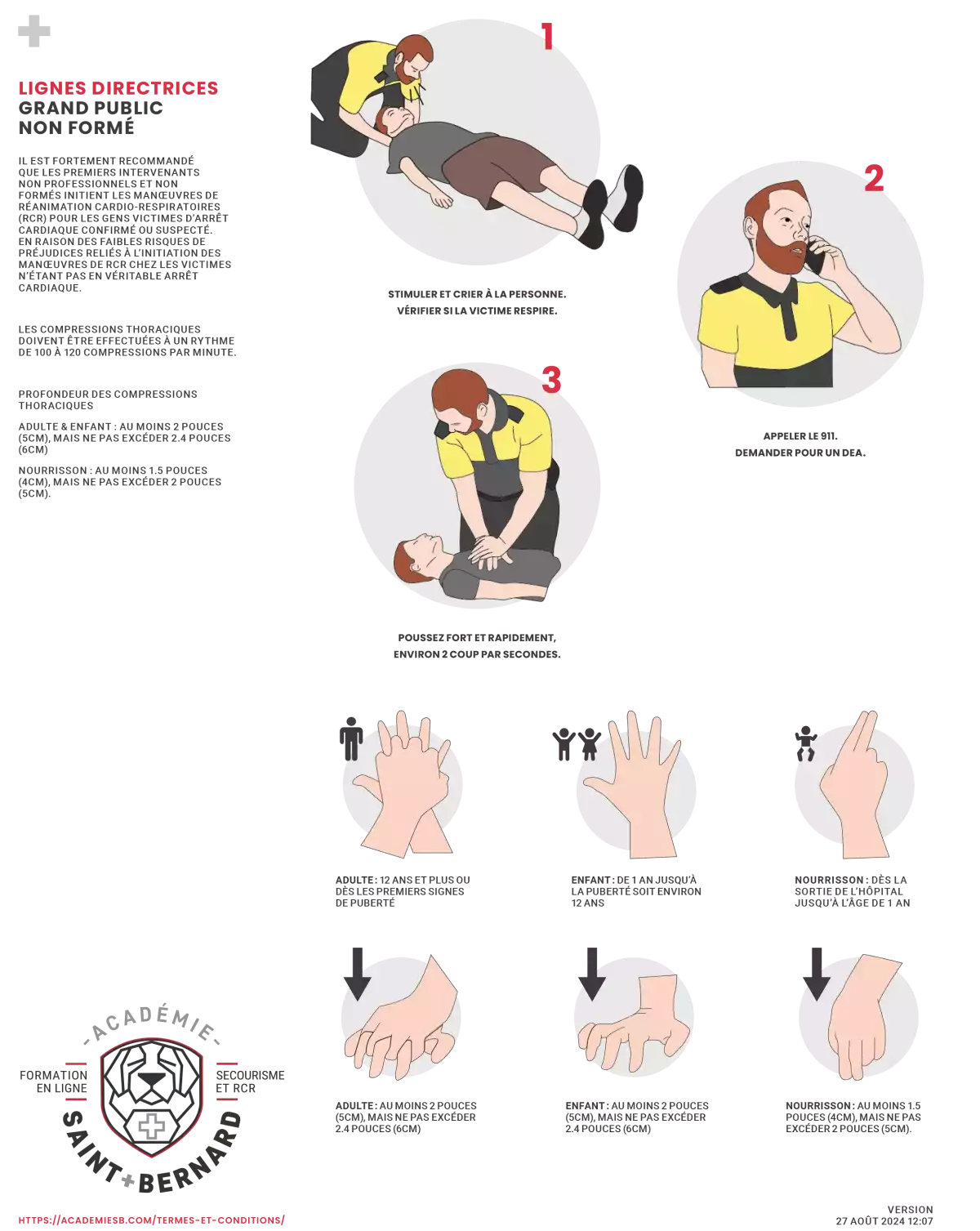SAINT-BERNARD ACADEMY GUIDELINES
National guidelines for CPR
The recommendations quoted below are based on studies carried out by ILCOR.
The guidelines we present here are the result of a rigorous synthesis of decisions from multiple scientific sources, drawn from national publications devoted to Cardiopulmonary Resuscitation (CPR) and Cardiovascular Emergency Care (ECC). These guidelines, which serve as the basis for clinical and pharmacological practice training in Canada, result from the aggregation of scientific data collected and recommendations arising from the most recent evidence-based assessments, developed by the International Liaison Committee on Resuscitation (ILCOR).

Summary of the guideline development process
___________________________
The development of CPR and ECC guidelines is based on careful analysis of relevant scientific data by a group of key players. Implemented by ILCOR, this process provides clear recommendations on how to deliver care in cardiovascular emergencies.
These guidelines for CPR and ECC are based on an international body of evidence and scientific research, constantly evaluated by ILCOR. The ILCOR evaluation process involves hundreds of international scientists and resuscitation experts, who review, discuss and debate thousands of peer-reviewed publications. As part of this process, ILCOR working groups prioritize topics for review, in close collaboration with resuscitation specialists. Once a topic is approved for review, a systematic review is implemented, led by a specialized knowledge synthesis unit or systematic reviewer, in collaboration with ILCOR content experts. At the end of this systematic review, ILCOR working groups analyze the evidence and formulate a draft Consensus on Science with Treatment Recommendations (CoSTR) statement, which is then made available for public comment. You can consult these CoSTR drafts online: https://costr.ilcor.org/document
The drafting groups of the ILCOR working group then compose a CoSTR summary taking into account the comments received. This summary is then used by resuscitation councils, such as the American Heart Association (AHA), to compose their own guidelines while taking into account their resources, training realities and the specifics of their healthcare system (AHA and Heart + Stroke, 2019).
Keys to the guideline development process
___________________________
ILCOR
ILCOR is a committee set up in 1992 to provide a forum for liaison between the world's leading resuscitation organizations. Its mission is to develop resuscitation guidelines with the help of its members. It plays a crucial role in evaluating, discussing and debating the thousands of peer-reviewed publications (ILCOR, n.d.).
To issue its recommendations, ILCOR forms working groups made up of hundreds of researchers and experts to conduct systematic reviews on specific topics. When drawing up guidelines, ILCOR working groups evaluate data from thousands of scientific publications and discuss the issues to be considered. They select priority topics for evaluation, with input from resuscitation professionals (AHA and Heart + Stroke, 2019).
The CoSTR
To ensure the ongoing evaluation of evidence, ILCOR calls on experts in systematic evaluation. They evaluate existing evidence relating to the priority themes selected by the ILCOR working groups, and carry out meta-analyses and syntheses of scientific data. The data gathered from the systematic evaluation of each priority theme is then analyzed by the working groups and compiled into CoSTR documents. Summaries of CoSTR documents are then used by resuscitation councils, such as the AHA, to develop their guidelines.
Académie Saint-Bernard Guidelines
___________________________
The following guidelines are based on official recommendations from ILCOR and its member resuscitation councils. They form the basis of our training programs, which are designed to prepare healthcare professionals and the Canadian public for the management of emergency situations.
Our guidelines are therefore based on research and data from a number of international scientific publications. These books contain information from international medical research and serve as the basis for CPR and ECC recommendations.
In summary
___________________________
The Académie Saint-Bernard is committed to offering high-quality training that enables its members to obtain highly respected certifications. We therefore rely on CPR and ECC guidelines developed on the basis of international scientific literature, reliable scientific data and a rigorous evaluation process conducted by ILCOR. The final recommendations, presented in the CoSTR summary, form the basis of our training programs and emergency care practices. Our commitment to these guidelines guarantees the quality and relevance of our training courses.
